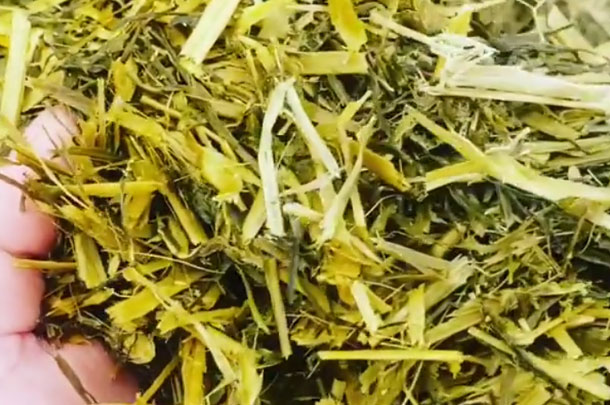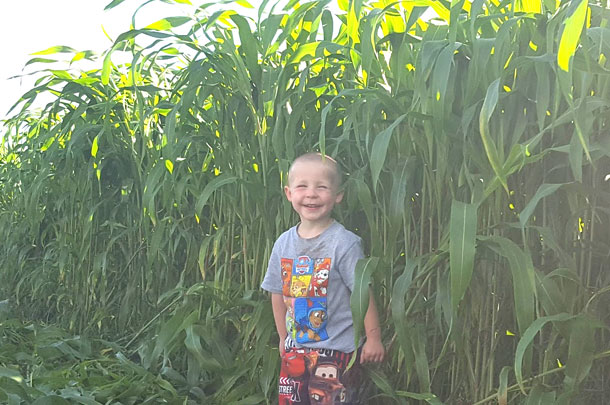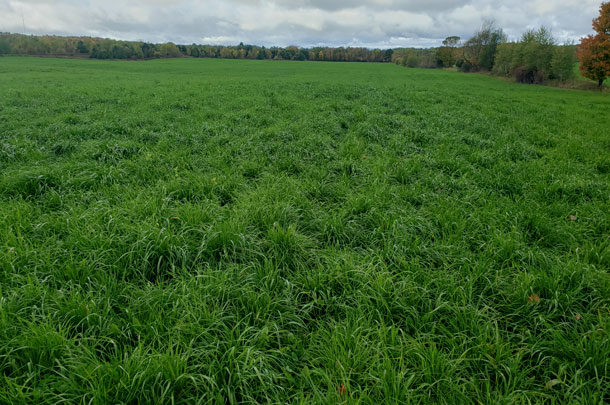The short version: When winterkill hit the alfalfa fields, Legacy Farms grew award-winning mixed grass haylage instead.
The longer version
With a 1,200-cow dairy, crops aren’t just a commodity to sell at the end of the season but must sustain the needs of a milking string. It’s important to get it right, especially when profit margins are tight. So, when about 300 acres of alfalfa were winterkilled in the brutal Wisconsin winter of 2018-19 (with essentially everything that wasn’t newly seeded alfalfa), the first cutting of hay yielded “mostly dandelions,” says Reuben Schloneger of Legacy Farms located in Shell Lake, Wisconsin.
Schloneger lobbied hard among other farm owners to try a new concept – no-till planting a grass-cocktail seed mix into the remaining alfalfa. “It was an experiment,” Schloneger says, “but what did we have to lose?” As with most Wisconsin dairies, the total mixed ration (TMR) includes a significant portion of hay and corn silage and is dependent upon their homegrown silages to keep the herd performing.
The proposed grass mix contained sorghum sudangrass, clover and Italian ryegrass, purchased through Byron Seeds. “It would be nice to have pure alfalfa,” Schloneger says, “because with the mix you’re relying heavily on depends on sorghum sudangrass for yield, and that makes us nervous. You have to cut it fairly high, and we worry that we’ll damage it when cutting it.” They overseeded the mix June 10, with a seeding rate equal to what they would have as if seeding a new crop.
The alfalfa-grass mix was chopped three times at 30-day intervals and stored in bunkers and piles. The last cutting – an October cutting at a seven-week instead of 30-day interval – sampled as high as 14% sugar. “It continued to grow even in freezing weather, so, with the cold temps and that high of a sugar content, when we fed it in January and February it was just like new-mown grass – it hadn’t fermented at all. It was like feeding greenchop directly.”

This sorghum sudangrass, alfalfa, rye, clover haylage tested 256 RFQ and smelled fresh when the bunker was opened. Photo by Reuben Schloneger.
But, how does it milk? “We milk Holsteins, and we’re running 3.35 protein and 4.3 butterfat,” Schloneger says. “We were happy with it, and we ended up with more inventory even with winterkill.” When a sample was sent to the World Forage Analysis Superbowl, it returned 256 relative feed quality (RFQ) – enough to earn it a second-place award in the mixed grass haylage division, sponsored by Lallemand Animal Nutrition.
See a video of this award-winning crop on the Legacy Farm Facebook page.
Legacy Farms crops about 3,000 acres. In addition to 600 acres haylage, 1,000 acres corn silage and 800 acres for grain corn, they raise 160 acres of soybeans and use the rest of the area for rye or oats. They do all their own spraying, harvesting, manure hauling and equipment operations.
“We’ve done a couple things more recently to improve efficiency with the dairy,” Schloneger says. “We switched to two milkings instead of three a day, and have started a purebred herd, moving to higher-quality cows.”

Benjamin Schloneger stands next to a stand of sorghum sundangrass, which was overseeded into winterkilled alfalfa. Photo by Reuben Schloneger.
Schloneger says it’s been a profitable year, in spite of industry-wide concerns. “The crops have done well, and we’re shipping milk to a good co-op now,” he says. With sand bedding, their somatic cell count has been 110,000 with zero treatments. “Once in a while we’ll treat a cow for mastitis, but it’s the exception,” he says.
“Everything is a gamble,” Schloneger says, “but we’re happy with [the new forage].”
And to think it all started with bad winterkill.












